
Following their own Flight Plan
Cape Cod Life / July 2015 / Recreation & Activities
Writer: Chris White / Photographer: Dan Cutrona
Following their own Flight Plan

Cape Cod Life / July 2015 / Recreation & Activities
Writer: Chris White / Photographer: Dan Cutrona
Local women pilots share their love for aviation
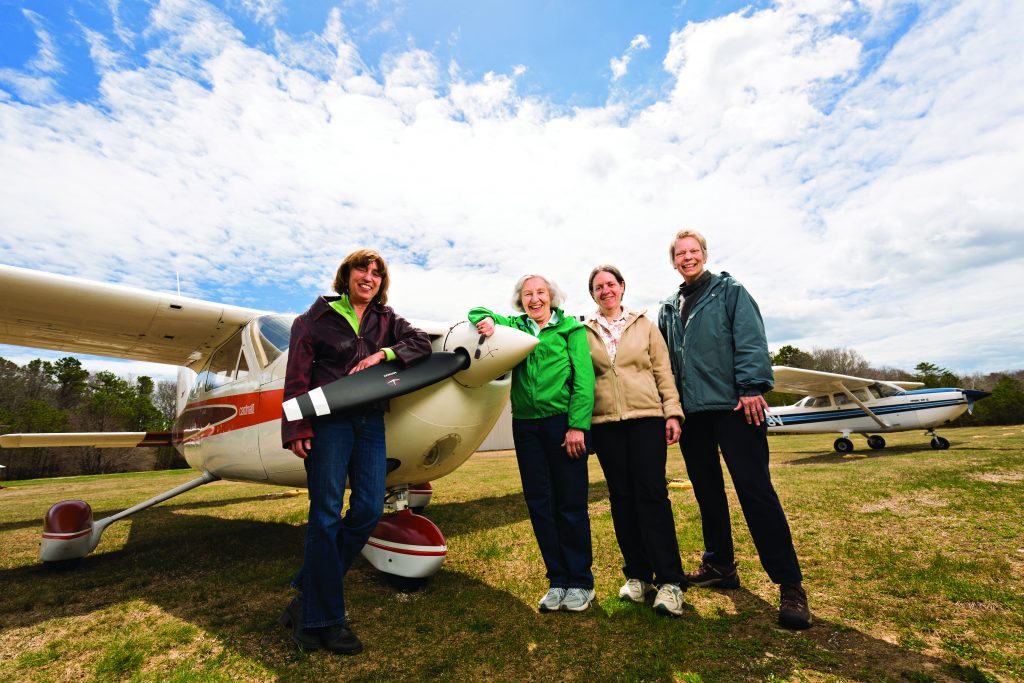
Photo by: Dan Cutrona
Amelia Earhart’s disappearance in 1937 remains one of America’s greatest mysteries. Nearly 80 years later, investigations into her final whereabouts continue; for example, earlier this year, The Travel Channel organized a televised—and ultimately unsuccessful—expedition with the goal of recovering the aviator’s remains. The nation’s most famous female pilot and ambassador of women’s aviation seemingly vanished into thin air, and though some have claimed to have discovered remnants of her plane, proof of Earhart’s final whereabouts remains a question mark. While the pilot’s actual bones are most likely somewhere near Fiji in the South Pacific, one might say pieces of her heart and soul have landed safely on a very distant island—Cape Cod. Nestled in the airfields of Falmouth and Marstons Mills, a community of women aviators is following Earhart in flight.
In April, Cape Cod LIFE met with six of these local pilots at the residence of Olga Mitchell, in the Falmouth Airpark, where fellow aviators Candie Oldham and Sherry Grobstein have also landed. Uniquely, most homes in the neighborhood feature not only a garage for the residents’ vehicles but also a hangar for their airplanes. The pilots can simply walk out their back doors, open up their hangars, and taxi their planes to the runway.
Though the pilots have a diverse range of flight experience, they each have a shared passion for aviation and are all members of the Ninety-Nines, Inc., the International Organization of Women Pilots of which Earhart was a founding member. During the course of a Sunday morning, the women shared how they got involved in flying, what they love so much about it, and a few anecdotes from their greatest aerial adventures.
“One of the hardest thing I’ve ever done.” – Arlene Meyers, Commercial Pilot
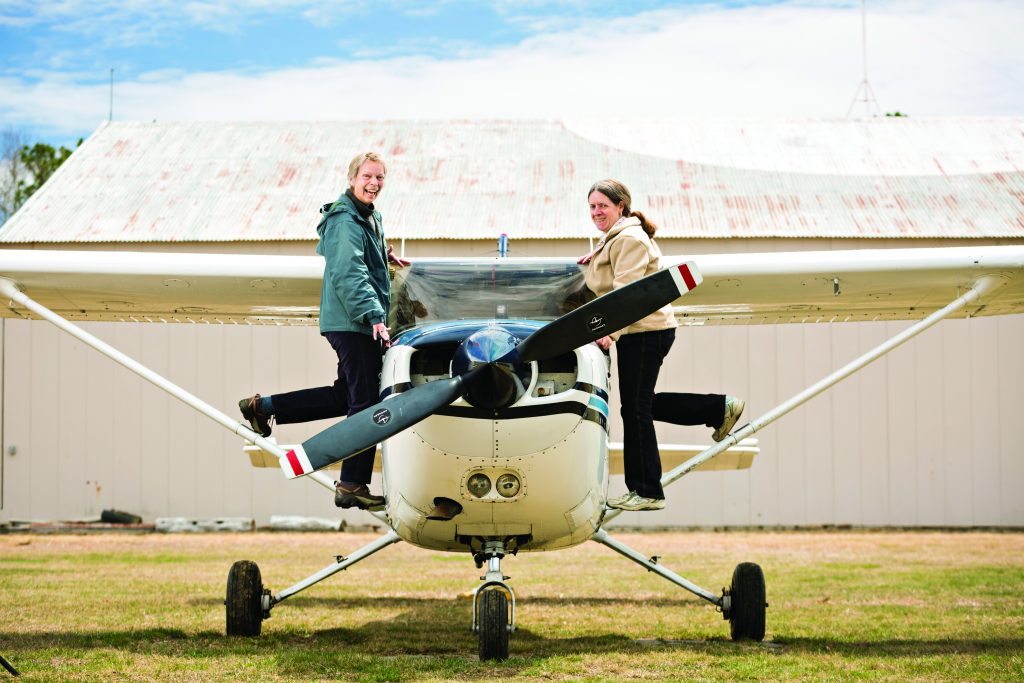
Photo by: Dan Cutrona
Arlene Meyers, 63, is a resident of Sandwich and a full-time acupuncturist in Mashpee. In the past, she also towed banner advertisements from the back of a company plane as a part-time job. “I first got into flying at age 45,” Meyers says. “I had a patient who was a pilot who had good success with acupuncture. He took me up on a thank-you flight.”
After six months of training, Meyers earned her pilot’s license. She immediately continued to the next level of certification and quickly completed her instrument rating qualifications, which permit pilots to fly in a wider variety of conditions, such as in the clouds and in low visibility. “It was one of the hardest things I’ve ever done,” she says.
The day after receiving her commercial pilot’s license, Meyers took her first job towing advertisements. “Anyone who has seen banners down here on the Cape,” she says, “has seen me.”
In 2003, Meyers became a flight instructor, and she currently participates in volunteer flights for Lighthawk, a non-profit whose mission is “to accelerate conservation success through the powerful perspective of flight.” Pilots can sign up for a variety of flights to gather aerial images of conservation sites; most of Meyers’ work has been in the skies over Long Island, New York. “I love the environmental flying,” she says. “There’s a way you can see the estuaries and other areas from the air that’s unparalleled.”
Meyers adds that one aspect of her job as a flight instructor that she really enjoys is working with students, no matter their age, to teach them about her hobby. In this regard, though, she feels she’s not unique. “All the pilots I know love to share their love of flight,” she says.
Sherry Grobstein, 63, lives in a home that abuts Falmouth Airpark’s runway. A software engineer who now works part-time, Grobstein started flying in 1970. “I always wanted to fly,” she recalls. “I watched birds, and I just wanted to be up there.”
During her senior year in high school, one of Grobstein’s teachers—a licensed pilot—offered to take some of his students on a flight. “I thought this was the most wonderful thing in the universe,” she recalls. Soon after, she took to the air herself. “There was a sign at the airfield: ‘Flying Lessons $5’,” she says. “Even I had $5.” After attending MIT, Grobstein worked as an engineer and took her first flying lessons at Solberg Airport in New Jersey.
At the time of our interview, Grobstein’s plane, a Cessna Skyhawk XP that she purchased in 2014, was in the shop for maintenance, and after this year’s long, snowy winter, she was growing anxious to get up in the air. Even though she’s been flying for years, Grobstein still marvels at the wonder and beauty of flight, saying with incredulity, “this is just ridiculous, being 2,000 feet in the air in a little metal box.”
“You never stop learning.” – Olga Mitchell, Aerial Acrobat
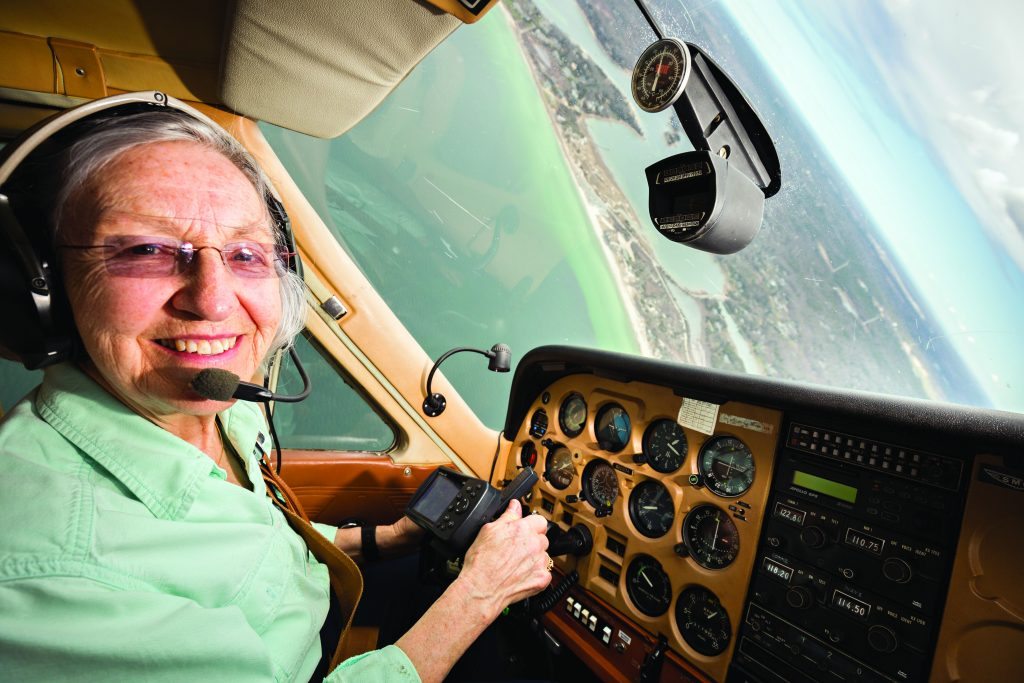
Photo by: Dan Cutrona
Olga Mitchell, 81, is the grand dame of this group of pilots. A flight instructor who still competes in races and aerobatics competitions, Mitchell says, “you never stop learning, and you learn by teaching.”
Mitchell, who moved to Falmouth in 2004, boarded a plane for the first time at the age of 12, but it was not until 18 years later, in 1972, that she earned her license. That achievement was followed soon after by receiving her instrument certification, and finally her commercial license. For much of her life, Mitchell flew and taught in the skies over her home state of New Jersey. “I’d take people to circle around the Statue of Liberty and up the Hudson River,” she recalls.
In the 1980s, Mitchell became interested in aerobatics—the art of flying in loops and spins for airshows—so she took lessons with The French Connection, a well-known aerobatics company in upstate New York. Mitchell now owns one plane she uses for aerobatics and a second for her other flying adventures. Just last summer, she took first prize in an aerobatics competition in Springfield, Vermont.
Though Mitchell has flown all over the country, competed in the 2013 Air Race Classic, and attended the 2014 AirVenture Oshkosh, an annual fly-in event for aviators in Wisconsin that regularly draws 10,000 pilots, she loves flying around the Cape and Islands. She flies to Provincetown, Chatham, Nantucket, and the Vineyard, among other destinations. “We fly to eat, by the way,” Mitchell says. The cost of fuel makes such trips expensive, though. “We joke about the $100 hamburger,” she says. “Well, more like $150, it’s gone up.”
“When it’s time to shoot, my co-pilot takes over.” – Margot Cheel, Aerial Photographer
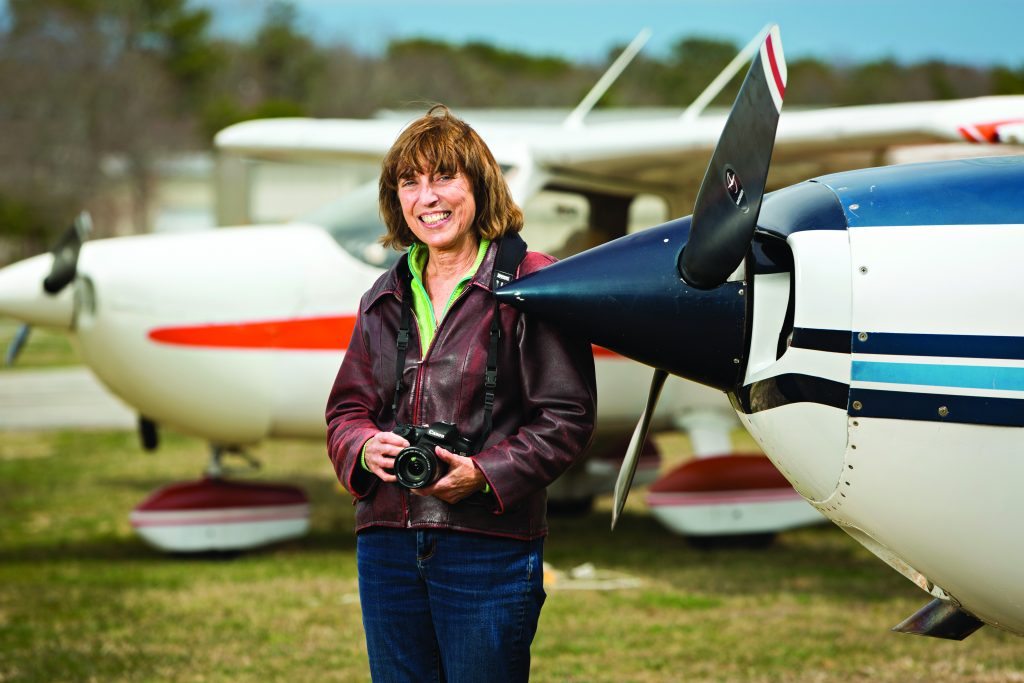
Photo by: Dan Cutrona
Margot Cheel, 69, of Cohasset, is a pilot and a past chairperson of the Eastern New England Chapter of the Ninety-Nines. She is also an aerial photographer and her work has appeared in many publications. In 2012, she released a book of aerial photography of the Cape and Islands titled Sea and Sand From the Sky. She explained one of her typical workdays. “I’ll fly to the location; then when it’s time to shoot, my co-pilot takes over flying the plane.”
A graduate of Middlebury College in Vermont where she majored in art, Cheel says what attracts her to flying is its visual appeal. Cheel says she did not become a pilot until her children were in college, yet soon after earning her pilot’s license, her life changed in a profound way.
“I volunteered to do a photo shoot,” she says, “and the beauty of it was just awesome. That was the beginning of my career.”
In 2013, Cheel teamed with Olga Mitchell to participate in the Air Race Classic, an annual all-women’s aviation event that traces its roots to the First Women’s Air Derby of 1929 and the Powder Puff Derby, which ran from the end of World War II through 1977. The course changes every year, but in 2013, the route began in Pasco, Washington and concluded in Fayetteville, Arkansas. On the return trip from Arkansas, Cheel and Mitchell, in an attempt to avoid some inclement weather, flew over Niagara Falls. “There’s a privilege to flying,” Cheel says, and this experience really underscored that belief.
“You have to learn the physics of flight.” – Sue Lin, Student Pilot
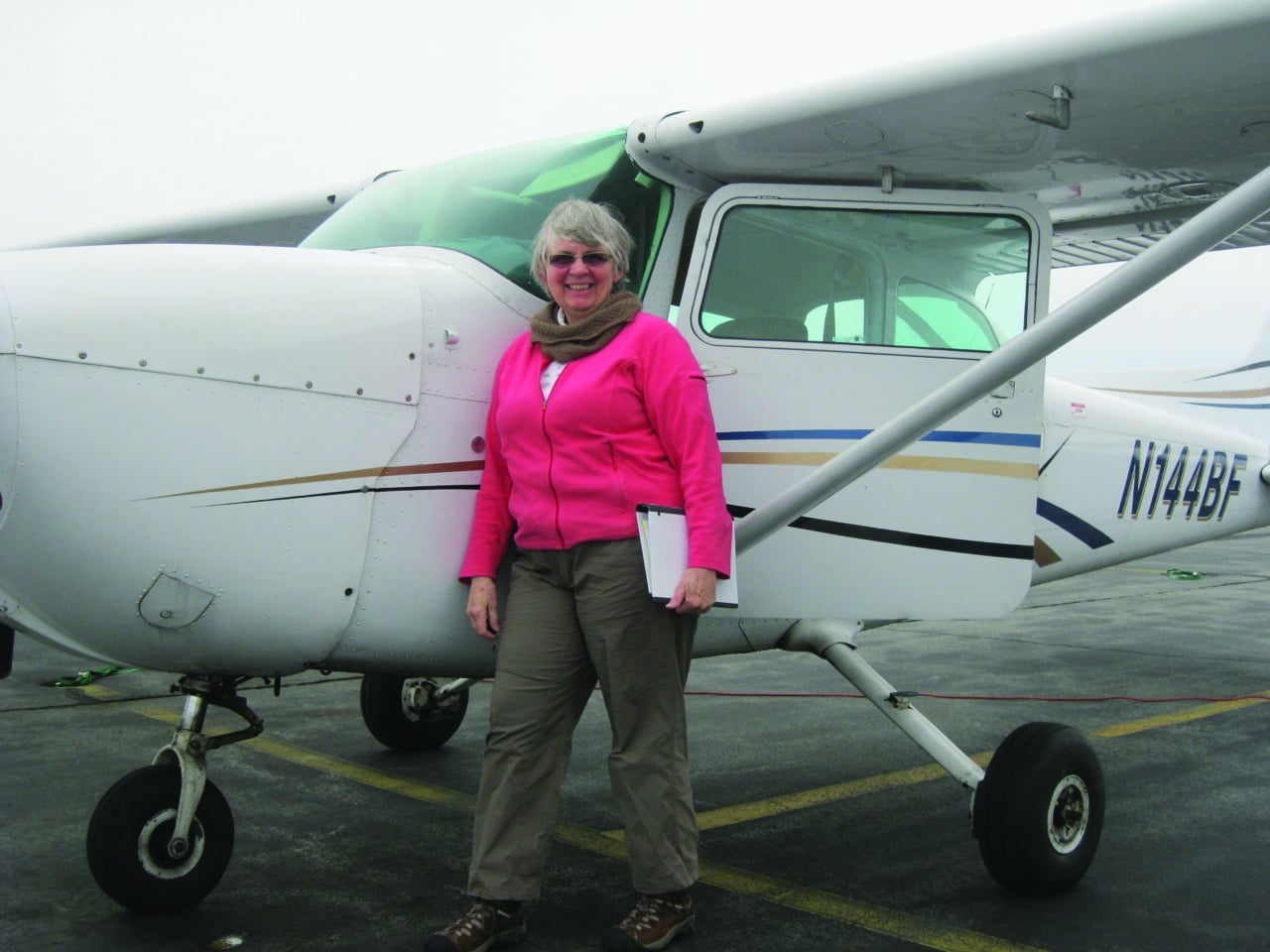
Photo by: Dan Cutrona
Sue Lin, 69, of Harwichport, is a student pilot who is in the process of becoming licensed. A retired juvenile court lawyer and restaurant owner, Lin has been flying for just over two years. “I never in my life thought about flying,” she says, “and I only wanted to do a sightseeing trip in Chatham. Turns out it’s cheaper to take a first lesson.”
Lin says her instructors’ ages have ranged from 22 to 92, and she schedules lessons when she travels. While she may have initially saved a few dollars on that sightseeing flight, she soon found herself behind the wheel of an expensive hobby. “I had no clue,” she says. “What hooked me was not the flying part, but the learning part.”
One of the many challenges novice aviators face, Lin says, is mastering the complex language of air traffic controllers, who speak in a kind of code. Another challenge is learning how airplanes function. “You have to learn the physics of flight,” she says. “You have to learn the mechanics. This is the fun part of flying for me, putting all these skills together—and flying the airplane.”
“I’m not going to be a non-flying wife.” – Candie Oldham, Flight Instructor
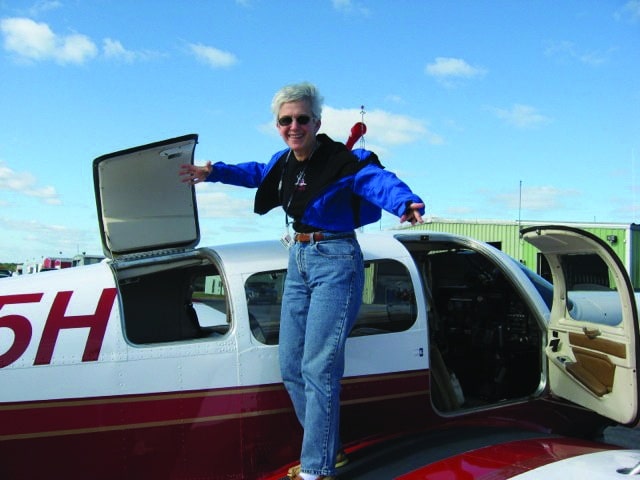
Photo by: Dan Cutrona
While her comrades all discovered flight on their own, for Candie Oldham, 62, her entry into this hobby was different. “My husband really had the interest,” she says, “and I thought, ‘I’m not going to be a ‘non-flying wife’.” Oldham, who works in the retail industry, is the third pilot of the group who lives in Falmouth Airpark, and she, too, is an instructor.
At the time of our interview, Oldham was preparing to compete in this year’s Air Race Classic, which was scheduled to begin June 22 in Fredericksburg, Virginia. Participants in the race have four days to complete all nine legs of the course, which will take them to North Carolina, Pennsylvania, Indiana, Michigan, Illinois, Tennessee, and two stops in Alabama, including the race terminus in the town of Fairhope.
For Oldham, the most exhilarating part of this event is the timing involved. Pilots must fly in low past each airport, where timers begin clocking them; then they fly to the next state—and the next timing point. “It’s a similar feel to sailboat racing [in terms of intensity] and very different from regular flying,” she says. “You’re going full speed, and you don’t want anyone to get in your way until you finish. It’s very exciting.”
For each of these women, flying is much more than a hobby. It has become a way of life, and for some, a career. Each of the women spoke of flying’s transformative qualities and the enrichment they have received from aviation. All six women further cited the importance of Amelia Earhart, and the famed aviator’s legacy, which includes the group she helped start back in 1929, the Ninety-Nines. At the group’s initial meeting, a total of 99 women attended, so the figure became the organization’s name. In the years since, the Ninety-Nines—including individuals like Mitchell, Cheel, Grobstein, Lin, Meyers, and Oldham—have carried the torch for women aviators. “Flying may not be all plain sailing,” Earhart once said, “but the fun of it is worth the price.”



